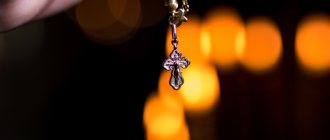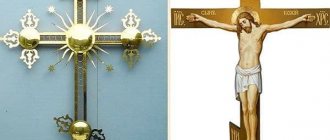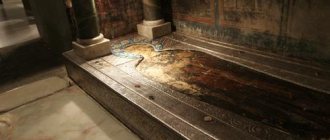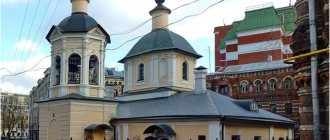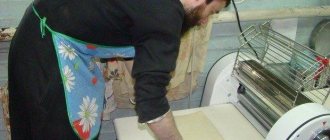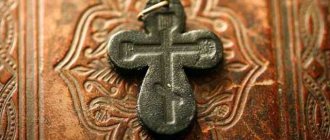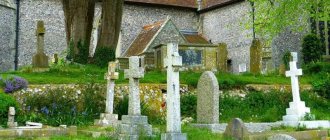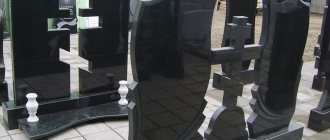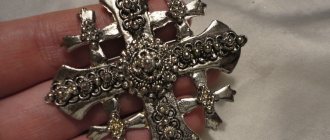Crosses on stone are found on almost every grave, and it does not matter whether the monument is made of granite in Grodno or in any other region of the country. This necessary religious attribute is used to design monuments both for believers and for those who did not have faith in God during their lifetime, but whose relatives honor funeral traditions. What the cross symbolizes and how to install it on the grave - we will understand in the article.
Proportions and dimensions of the cross on the grave
The dimensions of the cross on the grave themselves may be different, but they must correspond to the “Golden Ratio”. The cross bar of the cross should be equal to 1/3 of the height of the product itself, which is multiplied by 2 and it turns out that the upper end is 1/3 of the center of the cross.
The side strips should also be equal to 1/3, and the bottom part will be 2/3. An inclined strip is nailed to the bottom of the cross, which will be parallel to the top of the cross. The slope of the bar itself should be 45 degrees, and the length should be equal to the length of the sign.
The slanting crossbar on the cross represents the scales of justice. According to the Bible, two thieves were crucified on Golgotha, one was on the left side of Christ, and the other on the right. On the right side, the thief repented and received forgiveness, and this is indicated by the oblique end of the crossbar, which is directed upward.
Difference between Orthodox and Catholic crucifixes
Among all Christian denominations, crosses are especially revered in Orthodoxy and Catholicism. Catholics venerate the cross in one form: four ends with a long vertical crossbar. Catholics depict a dead Christ falling heavily, sometimes with blood dripping, with a wound from a spear, with numb hands and feet pierced by nails. On Catholic crucifixes, Jesus' feet are nailed with one nail, and on Orthodox crucifixes, with two. There are also differences in the inscriptions on the tablet above Jesus' head.
Orthodox crosses never depict a simple body. Orthodox believe that Jesus Christ is the second person of the Trinity, the Son of God and at the same time the human son of Mary, conceived without sin. Jesus Christ died on the cross to save all people, was resurrected and ascended to heaven. The Orthodox Church believes that one day he will return to judge all people. While on Catholic crucifixes Jesus is depicted dying after much suffering, in Orthodoxy he is full of strength after his resurrection.
How to make a metal cross with your own hands?
Temporary grave crosses are most often made of wood, but can also be made of metal. Previously, crosses were made of iron, sometimes they were coated with titanium coating; they could also use steel and cast iron.
Many people buy metal crosses in funeral stores, but sometimes loved ones make such a cross with their own hands. Again, its dimensions must comply with the proportions of the “Divine Section”.
In order to make this cross yourself, you need to select a profile pipe, as well as a plate on which to write down information about the deceased. Before installation, it is necessary to paint the products in the desired color. Afterwards, it is advisable to coat it with anti-corrosion varnish so that the iron does not become rusty.
Types of monuments
The photo shows two vertical monuments made of black gabbro. The design of tombstones is most optimal for the material - laser engraving, which is a high-quality and inexpensive way of decoration.
In the photo there is a marble horizontal monument for two. Portraits of the deceased are painted on ceramic photo ovals, inscriptions and a cross are engraved on the stele.
The photo shows an exclusive memorial complex. Despite the different shapes, the monuments are made in the same style from pink and black granite. In the background is a standard horizontal tombstone.
Tombstones and photo monuments differ not only in shape, but also in orientation - vertical or horizontal. The first option is most often used to designate a single burial. This orientation allows you to freely place a photograph of the deceased, name and years of life. If desired, there is room for additional design elements.
Horizontal monuments are more suitable for double (family) graves. It is optimal to place information about two deceased people on such products. However, if you wish, you can space three or more portraits evenly. In rare cases, horizontal headstones serve to mark the grave of a single person.
When choosing a monument, it is also important to take into account another parameter – size. It includes width, height and thickness. The average height of a tombstone is 100 cm, and accordingly, products below will be considered small, and above - large. The width depends on the orientation of the monument - vertical or horizontal. Thickness ranges from 5 to 15 cm.
The photo shows vertical monuments. The central tombstone is made of Bukinsky granite. The inscription is laid out in bronze letters; Star of David located on a tombstone. engraved.
In the photo there is a horizontal tombstone for two with a cross and a shroud, made of Gabbro-Diabase. Portraits of the deceased and inscriptions are transferred to the monument using laser engraving.
The photo shows a family memorial showing the size of the monuments. All tombstones are made of Karelian Gabbro-Diabase and decorated with laser engraving.
Is it possible to change the cross on a grave?
If the cross on the grave has become worn out and rotten over time, then it can be replaced with a new one, but the old cross must be burned.
The fact is that in the Russian Orthodox Church wood was the most common material from which crosses were created in the cemetery. Our ancestors did not paint crosses, i.e. left the material as it is.
But today, many are thinking about how to preserve the memory of a loved one, and so that the cross does not lose its appearance and lasts much longer, before covering the cross with varnish and stain, it is necessary to clean out all the irregularities and make the surface smooth. Then cover the cross with stain, and then with varnish. The varnish does not dry immediately after a certain period of time.
Some people cover the cross with wax, then it acquires a matte tint and this protects it from bark beetles and sunlight. There are several types of painting of crosses, but when choosing a coating, you need to pay attention so that the coating itself can protect the wood from environmental influences.
A cross is placed at the feet to emphasize that the deceased relied on faith
Is the cross placed at the feet or at the head? To be honest, at least from the side. This will also not affect the fate of the deceased in any way. But according to tradition, a cross is placed at the feet, and the deceased is placed with his head to the west, because the rays of the rising sun should symbolically see his face facing the east.
Sunrise is resurrection, and this position of the dead has been common since very ancient times throughout the globe.
Perhaps the cross at the feet echoes the image of the sun. But all these are indirect things that are far from Christian teaching.
This photo of the grave cross shows that the master put a lot of effort into the decorations: the “roof” is a cabbage roll, as they did before, the grape ornament is a Christian symbol. But with all this, the creator of the product made a big mistake - he positioned the bottom crossbar in a mirror manner. Photo: cs5.livemaster.ru
Superstitious priests and other representatives of “folk” religion (i.e., superstitions) say that it will be convenient for the deceased to lean on the cross when he crawls out of the grave at the Second Coming of Christ.
This is complete nonsense, which is alien to real Orthodoxy.
The most popular explanation for the position of the cross is symbolism. The deceased seems to be standing on the cross, that is, faith is the foundation of his eternal life, the person relies on it.
What to do with the cross after installing the monument?
Most priests argue that after a wooden cross is replaced with a monument, it must be burned and the remaining ashes scattered on the grave in the form of a Cross. If it is impossible to burn it, then in this case the cross is dismantled and buried in the tombstone.
The church allows the wooden cross to be cut and buried next to the grave or given to poor people who do not have the means to install such funeral paraphernalia.
If there is a church or chapel on the territory of the cemetery, then, as a rule, the cross is brought to the clergy, and they make sure that it is burned according to all the rules.
What kind of cross should be on the grave?
An Orthodox grave must have a tombstone cross. The cross can be made of stone or a monument in the form of a cross can be erected. You can also erect a monument with the image of a cross. It is desirable that it be a traditional Orthodox eight-pointed cross. If you can’t put up an eight-pointed cross, put up a four-pointed one, with a crucifix or not - it’s at your discretion.
Is it right to install a monument on a grave, or should there be a cross?
There should be a cross on the grave of an Orthodox Christian. It should be thought that for our deceased relatives, our prayer and alms for them are of paramount importance, while the presence, size, color and other aesthetics of tombstones cannot have any special significance for the posthumous state of souls and the future resurrection from the dead. The monument—that’s why it’s called that, because it’s erected so that the living remember” their dead—it’s for us, not for them. You can make an image of a cross on a stone monument; it will be both Christian and more durable.
Before installing a monument on a grave, is it possible to remove the cross from the grave and not put it up again?
Yes, that's what they usually do. The only thing is that you need to make an image of the Holy Cross on the monument itself.
A subburial was made in the grave of an old burial, on which only a cross stood. We want to erect a monument with a cross. Should I keep the old cross?
There are no church rules on this matter. If the cross is still strong enough, then you can leave it, if there is the necessary space on the grave. If the cross has become dilapidated, then it must be disposed of, or better yet, burned.
There is a monument at the grave. There is no cross on the monument. What to do?
You can change the monument to a cross, to a monument in the form of a cross, or to carve a cross on the monument. Then you will need to invite a priest and serve a memorial service at the grave.
Is it possible to leave a grave without a monument and a cross, is this acceptable?
It’s not entirely clear why to do this? Somehow, this is still not very accepted, regardless of issues of religion as such. Most existing religious traditions mark and decorate existing burial sites in one way or another. Among non-believers, a monument on a grave is also a very common tradition.
Why can’t a monument be erected before a year?
The tradition of placing a monument on a grave only after the anniversary is not caused by church regulations, but rather by technical reasons for the installation. They don’t install it only because the soil has not completely settled and the stone may tilt. If the soil is hard enough, then you can do it at any time and not wait a year. Therefore, you can decide the issue of installation timing at your own discretion.
What images are acceptable on a monument?
There must be an image of the Cross at the top of the monument. Below it are possible images of holy saints. Below is an image of the deceased and memorial inscriptions.
What is the significance of the images of saints on the back of the monument?
Orthodox Christians place a cross on the grave as a sign of our faith and that of the deceased. For the same reason, icons are depicted on monuments. It is more logical to depict them not from the back, but from the front, but there is usually a photograph of the deceased there. Images of saints can be located on both the front and back sides of the monument, or on both sides.
Is it possible to mount a photograph on the monument?
There are no prohibitions on placing photographs on grave monuments. Moreover, this is very appropriate, because when we pass by a “faceless” monument, nothing happens in our soul - we just see a piece of stone. But when a “living” person looks at us from a photograph, we begin to understand that this person was the same as us, he had the same concerns as us, we begin to empathize with him. Looking at such a photograph, we already want to pray for the deceased, and perhaps our prayer will bring comfort to the deceased.
Is it possible to draw on a monument a deceased person who is laughing in the photo?
Of course you can. You want to see a familiar face when you come to her grave. And since you are erecting a monument, choose the image in agreement with your loved ones.
The sign with the name and dates of birth and death broke in half. What to do?
The sign broke because it is outdoors and exposed to weather conditions (snow, rain). Order a new sign and don’t worry yourself with empty worries. But you must definitely pray for the departed - both at home and in church.
Is it possible to replace an old monument with a new one?
Monuments have meaning for the living, but the dead need something else - prayer and good memory of them. Prayer, both individual and church. You can periodically order a magpie for repose, or at least a one-time commemoration at the proskomedia, and also submit notes for a memorial service for the deceased. In general, the replacement of a monument is of a purely everyday and economic nature. So just ask the cemetery how they dispose of old monuments and don't worry about it.
Isn’t it a sin to order a monument for yourself in advance?
In Orthodoxy there is a tradition of preparing a coffin and a cross for yourself during your lifetime. Many saints did this, and there is nothing wrong with it. This is a remembrance of death that every Christian, especially the elderly, should have.
What to do with the dilapidated wooden cross and damaged photographs?
To avoid desecration, you can burn it or saw it into pieces and burn it again. It is usually customary to burn old wooden crosses somewhere on the outskirts of the cemetery, in a convenient place for this. You can take it to the temple and ask to be burned there. A damaged photograph can also be burned along with the cross.
Where to put the medallion from the old monument?
It probably wouldn't be a good idea to throw this locket away, so you can take it home and keep it with your family photos.
Is it true that soil from one grave cannot be poured onto another?
There are no rules in the church that would indicate that you cannot take soil from one grave to another. The main thing is to pray for your departed, and visit church more often, confess and receive communion.
Is it true that young people cannot bring fresh flowers to the cemetery?
Regarding flowers, this is definitely a superstition. Fresh flowers in a cemetery are a symbol of the eternal life of the deceased. And superstitions are born from ignorance and unwillingness to study one’s faith.
Is it true that you can’t take anything from a cemetery?
This is a typical superstition. Another thing is that from a practical point of view, this makes no sense. After all, the dead need our prayer, and we need their memory.
Engraving
Engraving a cross on a monument
Engraving a cross on a granite monument will cost less than other options. Thanks to engraving, a cross on a monument can take on the most bizarre shapes. You can change the vector of the crossbars, create additional bends, and add other images.
In addition to Jesus Christ, the Mother of God, saints and angels are often depicted nearby. You can add non-religious images, the most popular option is flowers that grow around the cross. Sometimes a hand or heart is depicted (as a symbol of mercy).
Eight-pointed cross-Golgotha
The most complete type of Orthodox cross is the Golgotha cross. This symbol contains many details that reflect the meaning of Orthodox doctrine.
The eight-pointed cross stands on a symbolic image of Mount Golgotha, on which, as it is written in the Gospel, the crucifixion of Christ took place.
To the left and right of the mountain are the letter signatures of G.G. (Mount Golgotha) and M.L. R.B. (Place of Execution Crucified Byst or, according to another version, Place of Execution Paradise Byst - according to legend, at the site of the execution of Christ there was once Paradise and the forefather of humanity, Adam, was buried here).
Under the mountain there is a skull and bones - this is a symbolic image of the remains of Adam. Christ “washed” his bones with his blood, saving humanity from original sin.
The bones are arranged in the order in which the hands are folded during communion or burial, and the letters G.A. located near the skull indicate the words Head of Adam.
To the left and right of the cross are depicted the instruments of Christ’s execution: on the left is a spear, on the right is a sponge with the corresponding letter signatures (K. and G.). According to the Gospel, a warrior brought a sponge on a cane, soaked in vinegar, to Christ’s lips, and another warrior pierced his ribs with a spear.
Behind the cross there is usually a circle - this is the crown of thorns of Christ.
On the sides of the cross of Golgotha there are inscriptions: Isa. Xs. (short form of Jesus Christ), King of Glory, and Ni Ka (meaning Conqueror).
As you can see, the Golgotha cross is the most complete form of the Orthodox Christian cross in terms of symbolic content.
Eight-pointed cross
The eight-pointed cross is a more complete form of the Orthodox cross.
The upper crossbar, which distinguishes the cross from the six-pointed one, symbolizes the tablet with the inscription (title), which was nailed to the cross also after the crucifixion, by order of Pontius Pilate, the Roman prefect of Judea. Partly in mockery, partly to indicate the “guilt” of the crucified man, the tablet read in three languages: “Jesus of Nazareth, King of the Jews” (I.N.C.I.).
Thus, the meaning of the six-pointed and eight-pointed crosses is the same, but the eight-pointed cross is more rich in symbolic content.
